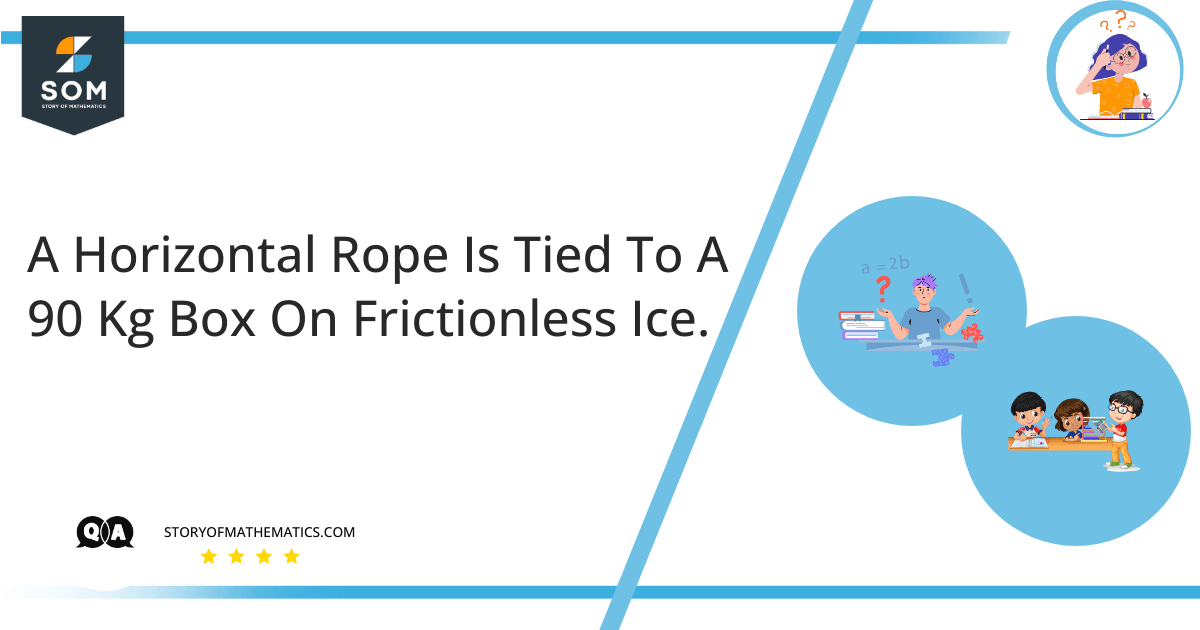
The question aims to find the tension in a rope having some weight in different conditions when the box is at rest, moving with constant velocity, and moving with some value of speed and acceleration. Tension is defined as the force transmitted by a rope, string, or wire when pulled by forces acting from opposite sides. The pulling force is directed along the length of the wire, pulling energy evenly onto the bodies at the ends.
For example, if a person pulls on an immaterial rope with a force of $40\: N$, a force of $40\: N$ also acts on the block. All immaterial ropes are subject to two opposite and equal tension forces. Here, a person is pulling a block with a rope, so the rope experiences a net force. Therefore, two opposing and equal tensile forces act on all massless strings. When a person pulls on a block, the rope experiences tension in one direction from the pull and tension in the other direction from the reactive force of the block.
The formula for the tension in the rope is:
\[T=ma+mg\]
Where $T$ is the tension, $m$ is the mass, $a$ is the acceleration, and $g$ is the gravitational force.
Expert Answer
Given data: $50\:kg$
Part(a)
The box is at rest, that is, it is not moving, the acceleration is zero if it is accelerated by zero, the sum of all the forces acting on the box is zero.
According to Newton’s second law of motion:
\[F=ma\]
\[F=m.(0 \dfrac{m}{s^{2}})\]
\[F=0\:N\]
\[T_{1}=0\:N\]
Part(b)
\[v=5\dfrac{m}{s}\]
The box moves at a constant speed. The acceleration is zero in this case.
\[F=ma\]
\[F=m.(0 \dfrac{m}{s^{2}})\]
\[F=0\:N\]
\[T_{2}=0\:N\]
Part(c)
\[v_{x}=5\dfrac{m}{s}\]
\[a_{x}=5\dfrac{m}{s^{2}}\]
Acceleration is not zero in this case.
\[F=ma\]
\[F=(50\:kg)(5\dfrac{m}{s^{2}})\]
\[F=250\:N\]
\[T_{3}=250\:N\]
Numerical Result
The tension in the rope when the box is at rest is:
\[T_{1}=0\:N\]
The tension in the rope when the box moves at a steady speed is:
\[T_{2}=0\:N\]
The tension in the rope when the box moves with velocity $v_{x}=5\dfrac{m}{s}$ and acceleration $a_{x}=5\dfrac{m}{s^{2}}$ is:
\[T_{3}=250\:N\]
Example
A horizontal rope is tied to a $60\:kg$ crate on frictionless ice. What is the tension in the rope if:
Part(a) Is the box at rest?
Part(b) Is the box moving at a constant speed of $10.0\: m/s$?
Part(c) The box has $v_{x}=10\dfrac{m}{s}$ and acceleration $a_{x}=10\dfrac{m}{s^{2}}$
Solution
Given data: $60\:kg$
Part(a)
The box is at rest, that is, it is not moving, the acceleration is zero if it is accelerated by zero, the sum of all the forces acting on the box is zero.
According to Newton’s second law of motion:
\[F=ma\]
\[F=m.(0 \dfrac{m}{s^{2}})\]
\[F=0\:N\]
\[T_{1}=0\:N\]
Part(b)
\[v=10\dfrac{m}{s}\]
The box moves at a constant speed. The acceleration is zero in this case.
\[F=ma\]
\[F=m.(0 \dfrac{m}{s^{2}})\]
\[F=0\:N\]
\[T_{2}=0\:N\]
Part(c)
\[v_{x}=10\dfrac{m}{s}\]
\[a_{x}=10\dfrac{m}{s^{2}}\]
Acceleration is not zero in this case.
\[F=ma\]
\[F=(60\:kg)(10\dfrac{m}{s^{2}})\]
\[F=600\:N\]
\[T_{3}=600\:N\]
The tension in the rope when the box is at rest is:
\[T_{1}=0\:N\]
The tension in the rope when the box moves at a steady speed is:
\[T_{2}=0\:N\]
The tension in the rope when the box moves with velocity $v_{x}=10\dfrac{m}{s}$ and acceleration $a_{x}=10\dfrac{m}{s^{2}}$ is:
\[T_{3}=600\:N\]
